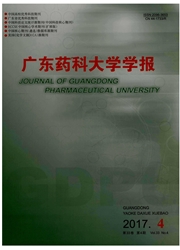

 中文摘要:
中文摘要:
目的 分析高脂喂养联合低剂量链脲佐菌素(streptozocin,STZ)诱导的2型糖尿病肾病(type 2 diabetic nephropathy,T2DN)大鼠模型在不同时期尿液代谢组学的差异,寻找T2DN早期代谢标志物并分析T2DN发病机制.方法 18只SD大鼠随机分为T2DN组(n=12)和正常组(n=6),T2DN组采用高脂喂养4周后空腹注射STZ(40 mg/kg)建立T2DN模型;正常组正常饲料喂养并注射等剂量的柠檬酸缓冲液作为对照.分别于第8、12、16周代谢笼收集尿液,通过1 H NMR技术检测其尿液代谢组学特征,采用模式识别方法分析疾病进展过程中的代谢差异.结果 模型组中9只大鼠发展为T2DN模型,成模率为75%.模式识别方法分析显示正常组、T2DN组第8周、T2DN组第12周和T2DN组第16周大鼠的尿液有明显的代谢差异,这些差异代谢涉及能量代谢、三羧酸循环、脂代谢、氨基酸代谢及肠道菌群.结论 随着T2DN大鼠病程的进展,其尿液中的代谢谱发生显著的变化,这些具有显著性变化的代谢物可以为T2DN的早期诊断和探索T2DN的发病机制提供帮助.
 英文摘要:
英文摘要:
Objective To study the characteristic metabolic alterations of urine during progression of a high-fat diet and low dose streptozocin ( STZ)-induced type 2 diabetic nephropathy ( T2DN) model, identify early biomarkers for clinical diagnosis and analyze the pathogenesis of T2DN. Methods Rats were randomly divided into the T2DN group ( n=12) and the control group ( n=6) . The T2DN rats were fed with a high-fat diet for 4 weeks followed by single intraperitoneal injection of STZ ( 40 mg/kg) , and the control rats were injected with the equal volume of sodium citrate. Each urine sample was collected at 8, 12 and 16 weeks and measured by 1 H NMR. The characteristic metabolic alterations during T2DN progression were analyzed by pattern recognition. Results In the T2DN group, 9 rats were developed into T2DN rats and the success ratio was 75%. There was a clear difference between the control group and the T2DN group at 8, 12 and 16 weeks by pattern recognition analysis. The potential biomarkers were involved in many metabolic pathways including energy metabolism, tricarboxylic acid ( TCA) cycle, lipid metabolism, amino acid metabolism and gut microflora. Conclusion There are significant differences in metabolic changes during T2DN progress, which may serve as the potential biomarkers for early T2DN diagnosis and analysis of T2DN mechanisms.
 同期刊论文项目
同期刊论文项目
 同项目期刊论文
同项目期刊论文
 期刊信息
期刊信息
